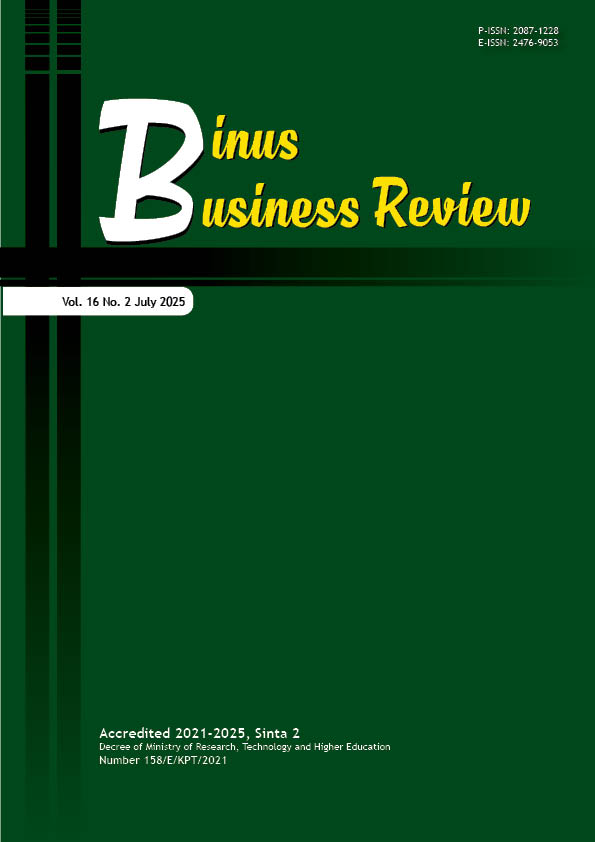Understanding Generation Z’s Shopping Interest on E-Commerce ‘T’: The Role of Usefulness, Trust, User Interface, and Ease of Use in the Bekasi Area
DOI:
https://doi.org/10.21512/bbr.v16i2.12796Keywords:
Generation Z, shopping interest, usefulness, user interface, trust, ease of useAbstract
Despite the rapid growth of Internet users in Indonesia, e-commerce has experienced a notable decline in visitor traffic, raising concerns about shifting consumer behaviors, particularly among young shoppers. The research sought to identify the key drivers and barriers influencing Generation Z’s shopping interest in e-commerce ‘T’, focusing on the Bekasi region—a rapidly urbanizing area with high digital adoption rates among youth. The research examined perceived usefulness, trust, user interface, and ease of use, applying the Technology Acceptance Model (TAM) as a theoretical foundation. Using a quantitative approach, data were collected from 150 Generation Z respondents in Bekasi through structured questionnaires. The responses were analyzed using path analysis in SPSS to determine the strength and significance of each variable’s impact on shopping interest. The results indicate that perceived usefulness (β = 0.406, p < 0.05), trust (β = 0.248, p < 0.05), and user interface (β = 0.173, p < 0.05) significantly influence shopping interest, while perceived ease of use (p > 0.05) does not have a statistically significant effect. These findings suggest that Generation Z prioritizes functional benefits (usefulness), platform reliability (trust), and an engaging digital experience (user interface design) over mere simplicity. The research contributes to existing literature by providing demographic and geographic specificity, analyzing young consumers in Bekasi, a key market often underrepresented in e-commerce research. The insights provide practical recommendations for e-commerce platforms to refine their strategy, emphasizing feature utility, trust-building mechanisms, and user interface or experience enhancements to better attract and retain young shoppers.
References
Al-Maroof, R. S., Salloum, S. A., Hassanien, A. E., & Shaalan, K. (2023). Fear from COVID-19 and technology adoption: The impact of Google Meet during Coronavirus pandemic. Interactive Learning Environments, 31(3), 1293–1308. https://doi.org/10.1080/10494820.2020.1830121
Bai, Y., & Li, H. (2022). Mapping the evolution of e-commerce research through co-word analysis: 2001–2020. Electronic Commerce Research and Applications, 55, 1–15. https://doi.org/10.1016/j.elerap.2022.101190
Da Silva, M. A. D. A. L., Mariano, A. M., Santos, M. R., Collazos, C. C., Murillo, P. D., Sandoval, T. R. D., & Loaiza-Torres, J. (2024). The impact of persuasion, usefulness, and credibility on user intent in e-commerce applications. Procedia Computer Science, 242, 123–129. https://doi.org/10.1016/j.procs.2024.08.245
Davis, F. D. (1989). Perceived usefulness, perceived ease of use, and user acceptance of information technology. MIS Quarterly, 13(3), 319–340. https://doi.org/https://doi.org/10.2307/249008
Dihni, V. A. (2022, July 19). 10 e-commerce dengan pengunjung terbanyak kuartal I 2022. Databoks. https://databoks.katadata.co.id/datapublish/2022/07/19/10-e-commerce-dengan-pengunjung-terbanyak-kuartal-i-2022
Dreyer, C., & Stojanová, H. (2023). How entrepreneurial is German Generation Z vs. Generation Y? A literature review. Procedia Computer Science, 217, 155–164. https://doi.org/10.1016/j.procs.2022.12.211
Falcone, R., Barber, S., Korba, L., & Singh, M. (2023). Trust, reputation, and security: Theories and practice. In AAMAS 2002 International Workshop. Springer Berlin.
Gefen, D. (2003). TAM or just plain habit: A look at experienced online shoppers. Journal of Organizational and End User Computing (JOEUC), 15(3), 1–13. https://doi.org/https://doi.org/10.4018/joeuc.2003070101
Hair, J. F., Black, W. C., Babin, B. J., & Anderson, R. E. (2019). Multivariate data analysis (8th ed.). Cengage.
Katadata Insight Center. (2023, Juni). Laporan perilaku konsumen e-commerce Indonesia 2023: Pemulihan ekonomi dan tren belanja pasca pandemi. https://kredivocorp.com/wp-content/uploads/2023/06/2023-Indonesia-e-Commerce-Behavior-Report.pdf
Liu, Y., & Martens, J. B. (2024). Conversation-based hybrid UI for the repertory grid technique: A lab experiment into automation of qualitative surveys. International Journal of Human-Computer Studies, 184, 1–16. https://doi.org/10.1016/j.ijhcs.2024.103227
Mohr, S., & Kühl, R. (2021). Acceptance of artificial intelligence in German agriculture: An application of the technology acceptance model and the theory of planned behavior. Precision Agriculture, 22, 1816–1844. https://doi.org/10.1007/s11119-021-09814-x
Mulyono, & Suprapto, A. T. (2021). The impact of e-business on competitive advantage through innovation organization on financial company listed at Indonesia stock exchange. In IOP Conference Series: Earth and Environmental Science. IOP Publishing. https://doi.org/10.1088/1755-1315/729/1/012135
Nguyen, T. T. U., Nguyen, P. V., Huynh, H. T. N., Truong, G. Q., & Do, L. (2024). Unlocking e-government adoption: Exploring the role of perceived usefulness, ease of use, trust, and social media engagement in Vietnam. Journal of Open Innovation: Technology, Market, and Complexity, 10(2), 1–10. https://doi.org/10.1016/j.joitmc.2024.100291
Philippi, P., Baumeister, H., Apolinário-Hagen, J., Ebert, D. D., Hennemann, S., Kott, L., ... & Terhorst, Y. (2021). Acceptance towards digital health interventions – Model validation and further development of the unified theory of acceptance and use of technology. Internet Interventions, 26, 1–9. https://doi.org/10.1016/j.invent.2021.100459
Ru, L. J., Kowang, T. O., Long, C. S., Fun, F. S., & Fei, G. C. (2021). Factors influencing online purchase intention of Shopee’s consumers in Malaysia. International Journal of Academic Research in Business and Social Sciences, 11(1), 761–776. https://doi.org/10.6007/ijarbss/v11-i1/8577
Sadeghi, K., Ojha, D., Kaur, P., Mahto, R. V., & Dhir, A. (2024). Explainable artificial intelligence and agile decision-making in supply chain cyber resilience. Decision Support Systems, 180, 1–10. https://doi.org/10.1016/j.dss.2024.114194
Sohaib, M., & Han, H. (2023). Building value co-creation with social media marketing, brand trust, and brand loyalty. Journal of Retailing and Consumer Services, 74. https://doi.org/10.1016/j.jretconser.2023.103442
Syahri, W., Arif, M., & Nurwani. (2023). Analisis faktor-faktor yang mempengaruhi keputusan pembelian konsumen melalui aplikasi marketplace online di kalangan mahasiswa Fakultas Ekonomi dan Bisnis Islam Universitas Islam Negeri Sumatera Utara. OPTIMAL Jurnal Ekonomi dan Manajemen, 3(4), 179–197.
Tanoto, S. R., & Tami, E. G. (2024). Understanding Generation Z: Work-life balance and job embeddedness in retention dynamics. Binus Business Review, 15(3), 225–238. https://doi.org/10.21512/bbr.v15i3.11277
Venkatesh, V. (2022). Adoption and use of AI tools: A research agenda grounded in UTAUT. Annals of Operations Research, 308, 641–652. https://doi.org/10.1007/s10479-020-03918-9
Yuniarty, So, I. G., Abdinagoro, S. B., & Hamsal, M. (2022). Impact of the extended digital eco-dynamic on innovation performance: An empirical study on small e-businesses in Indonesia. Frontiers in Psychology, 13, 1–9. https://doi.org/10.3389/fpsyg.2022.864530
Zhao, L., Xu, Y., & Xu, X. (2023). The effects of trust and platform innovation characteristics on consumer behaviors in social commerce: A social influence perspective. Electronic Commerce Research and Applications, 60. https://doi.org/10.1016/j.elerap.2023.101284
Downloads
Published
How to Cite
Issue
Section
License
Copyright (c) 2025 Adi Teguh Suprapto, Kevin Yulianto, Kendrick

This work is licensed under a Creative Commons Attribution-ShareAlike 4.0 International License.
Authors who publish with this journal agree to the following terms:
a. Authors retain copyright and grant the journal right of first publication with the work simultaneously licensed under a Creative Commons Attribution License - Share Alike that allows others to share the work with an acknowledgment of the work's authorship and initial publication in this journal.
b. Authors are able to enter into separate, additional contractual arrangements for the non-exclusive distribution of the journal's published version of the work (e.g., post it to an institutional repository or publish it in a book), with an acknowledgment of its initial publication in this journal.
c. Authors are permitted and encouraged to post their work online (e.g., in institutional repositories or on their website) prior to and during the submission process, as it can lead to productive exchanges, as well as earlier and greater citation of published work.
USER RIGHTS
All articles published Open Access will be immediately and permanently free for everyone to read and download. We are continuously working with our author communities to select the best choice of license options, currently being defined for this journal as follows: Creative Commons Attribution-Share Alike (CC BY-SA)





















